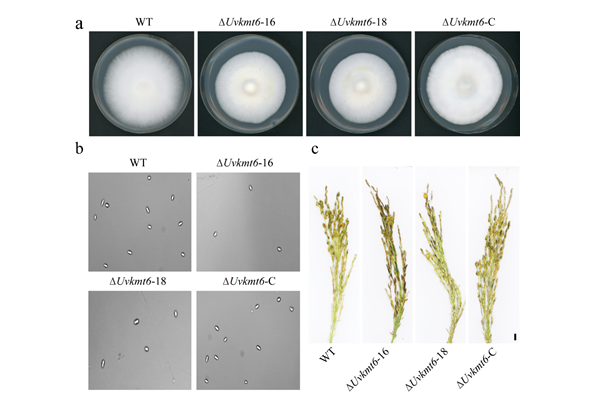






Scientists Further Reveal the Infection Mechanism of Ustilaginoidea virens
January 17th, 2022
Ustilaginoidea virens, the causal agent of the rice false smut disease, is an economically important fungal pathogen posing threats to rice production. The infection of U. virens not only reduces the quality and yield of rice, but also contaminates rice seeds and straws with toxins such as ustiloxins and ustilaginoidins. At present, the infection mechanism of U. virens is still largely unclear. Revealing its pathogenic mechanism is of great significance for formulating effective control strategies. Polycomb repressive complex 2 (PRC2) is responsible for the trimethylation of lysine 27 of histone H3 (H3K27me3)-mediated transcriptional silencing. At present, its biological roles in the devastating rice pathogenic fungus U. virens remain unclear.
Recently, a research article entitled “UvKmt6-mediated H3K27 trimethylation is required for development, pathogenicity, and stress response in Ustilaginoidea virens” has been published in Virulence by Prof. KOU Yanjun’s research team from State Key Laboratory of Rice Biology, China National Rice Research Institute (CNRRI) of Chinese Academy of Agricultural Sciences (CAAS) with Prof. LUO Chaoxi’s research team from Huazhong Agricultural University.
In this study, it was reported that UvKmt6, a putative epigenetic repressor polycomb repressive complex 2 (PRC2) catalytic subunit, participated in the transcription repression of genes encoding effectors, genes associated with secondary metabolites production and stress response-related genes. The role of UvKMT6 in influencing development, pathogenicity and stress response ability in the rice false smut fungus was illustrated, further revealing the the molecular mechanisms of rice-U. virens interaction.
The biological roles of H3K27me3 modification in U. virens were investigated. By disruption of UvKMT6, researchers found that UvKMT6 is essential for H3K27me3 modification and required for growth, conidiation and virulence.
Furthermore, in combination with ChIP-seq, RNA-seq and phenotypic analysis, researchers revealed that H3K27me3-mediated transcriptional repression had tight correlation with effector transcription, secondary metabolism and stress responses in U. virens.
MENG Shuai, LIU Zhiquan and SHI Huanbin contributed equally to this work as co-first authors. Prof. LIN Fucheng from Zhejiang Academy of Agricultural Sciences, Prof. TAO Zeng from Zhejiang University, etc. have also contributed to this work. The work was funded by the National Natural Science Foundation of China (31900127), key R&D project of China National Rice Research Institute (CNRRI-2020-04), Central Public-interest Scientific Institution Basal Research Fund of China National Rice Research Institute (CPSIBRF-CNRRI-202116), and “Elite Youth” program and Agricultural Sciences and Technologies Innovation Program under Chinese Academy of Agricultural Sciences.
Paper link: https://www.tandfonline.com/doi/full/10.1080/21505594.2021.2008150

· Study Reveals How the Clock Component OsLUX Regulates Rice Heading
· Scientists Further Unravelled the Underlying Mechanism of Heading Date Control in Rice
· Improving the efficiency of prime editing in rice
· A New Infection Mechanism of Ustilaginoidea virens is Revealed
· Scientists Further Reveal the Infection Mechanism of Ustilaginoidea virens
CNRRI Today
Copyright © 2014- China National Rice Research Institute